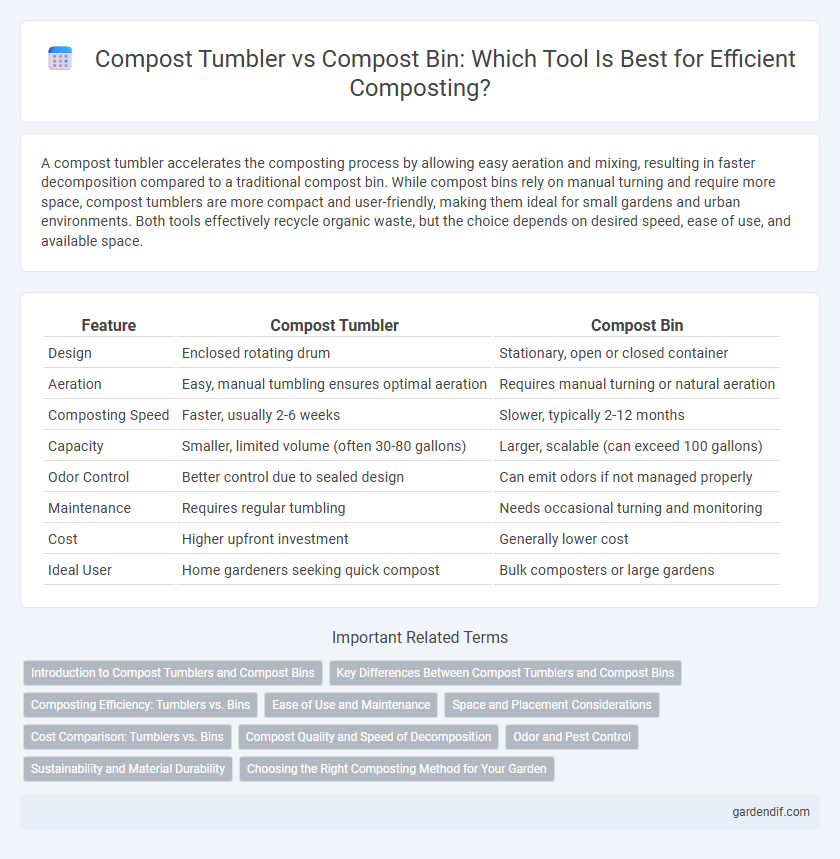
Compost tumbler vs compost bin Illustration
A compost tumbler accelerates the composting process by allowing easy aeration and mixing, resulting in faster decomposition compared to a traditional compost bin. While compost bins rely on manual turning and require more space, compost tumblers are more compact and user-friendly, making them ideal for small gardens and urban environments. Both tools effectively recycle organic waste, but the choice depends on desired speed, ease of use, and available space.
Table of Comparison
| Feature | Compost Tumbler | Compost Bin |
|---|---|---|
| Design | Enclosed rotating drum | Stationary, open or closed container |
| Aeration | Easy, manual tumbling ensures optimal aeration | Requires manual turning or natural aeration |
| Composting Speed | Faster, usually 2-6 weeks | Slower, typically 2-12 months |
| Capacity | Smaller, limited volume (often 30-80 gallons) | Larger, scalable (can exceed 100 gallons) |
| Odor Control | Better control due to sealed design | Can emit odors if not managed properly |
| Maintenance | Requires regular tumbling | Needs occasional turning and monitoring |
| Cost | Higher upfront investment | Generally lower cost |
| Ideal User | Home gardeners seeking quick compost | Bulk composters or large gardens |
Introduction to Compost Tumblers and Compost Bins
Compost tumblers are enclosed containers designed to aerate organic waste efficiently through regular rotation, speeding up the decomposition process and minimizing odors. Compost bins are stationary, often open or ventilated containers that rely on natural aeration and microbial activity to break down compost materials over time. Both tools serve as effective solutions for managing kitchen scraps and yard waste, with tumblers offering faster compost production and bins providing larger capacity for bulk organic matter.
Key Differences Between Compost Tumblers and Compost Bins
Compost tumblers feature a rotating drum design that accelerates decomposition through frequent aeration, while compost bins rely on static containment requiring manual turning to maintain oxygen levels. Tumblers typically offer faster composting cycles, often completing in weeks, compared to bins which may take several months. Additionally, tumblers provide a more rodent-resistant and odor-controlled environment, whereas bins offer larger capacity and simpler construction for bulkier yard waste.
Composting Efficiency: Tumblers vs. Bins
Compost tumblers accelerate decomposition by allowing easy turning and aeration, leading to faster nutrient-rich compost production within weeks. Compost bins rely on natural microbial activity and passive aeration, often requiring months to break down organic material efficiently. The enhanced oxygen flow in tumblers significantly improves composting efficiency compared to traditional bins.
Ease of Use and Maintenance
Compost tumblers offer superior ease of use by allowing effortless aeration through simple rotation, reducing manual turning and speeding up decomposition. In contrast, compost bins require frequent manual mixing and can be more challenging to manage moisture and airflow effectively. Maintenance for compost tumblers is generally lower, as their enclosed design minimizes pests and odor, while compost bins often demand regular monitoring to prevent odors and pest intrusion.
Space and Placement Considerations
Compost tumblers require less ground space due to their vertical design, making them ideal for small yards or limited garden areas. Compost bins often need more horizontal space and are better suited for larger outdoor areas with less strict placement constraints. Tumblers can be placed on patios or decks for easy access, while bins typically need stable, shaded ground locations for optimal composting.
Cost Comparison: Tumblers vs. Bins
Compost tumblers typically range from $100 to $300, reflecting their advanced design and ease of use, while compost bins are generally more affordable, costing between $30 and $150 depending on size and material. Tumblers offer faster composting through frequent aeration but involve higher upfront investment and potential maintenance costs, whereas bins provide a budget-friendly, low-maintenance option with slower decomposition rates. Evaluating long-term benefits and usage frequency is crucial when deciding between the premium pricing of tumblers and the economical appeal of traditional compost bins.
Compost Quality and Speed of Decomposition
Compost tumblers accelerate decomposition through frequent aeration, producing high-quality compost faster than traditional compost bins, which rely on passive aeration and microbial activity. The controlled environment in compost tumblers maintains optimal moisture and temperature levels, resulting in a more balanced nutrient-rich soil amendment. Compost bins, while slower, can accommodate larger volumes and are ideal for those prioritizing volume over rapid composting speed.
Odor and Pest Control
Compost tumblers offer superior odor and pest control compared to compost bins due to their enclosed design and regular turning mechanism, which promotes faster decomposition and reduces anaerobic conditions that cause foul smells. Compost bins, especially open or poorly ventilated types, are more prone to attracting pests such as rodents and flies, as well as generating strong odors from stagnant organic matter. For efficient odor management and pest prevention, a compost tumbler with secure lids and tight seals is the preferred option in residential composting.
Sustainability and Material Durability
Compost tumblers, typically made from durable plastics or metals, offer enhanced sustainability by accelerating the composting process through efficient aeration and easy turning, reducing organic waste volume quicker than traditional compost bins. In contrast, compost bins, often constructed from recycled wood or heavy-duty plastic, provide long-lasting material durability and allow for larger compost volumes, making them suitable for sustainable garden waste management over extended periods. Choosing between a compost tumbler and a compost bin depends on balancing rapid decomposition needs with the durability and volume capacity required for sustainable waste reduction.
Choosing the Right Composting Method for Your Garden
A compost tumbler accelerates decomposition through easy turning, making it ideal for gardeners seeking faster nutrient-rich compost with minimal effort. Compost bins offer larger capacity and simpler construction, suitable for those with more space and time to manage slower breakdown processes. Selecting the right method depends on garden size, desired composting speed, and user convenience preferences.
Compost tumbler vs compost bin Infographic

 gardendif.com
gardendif.com